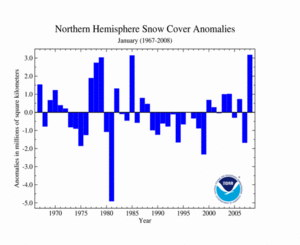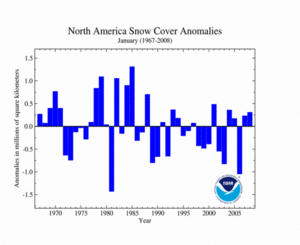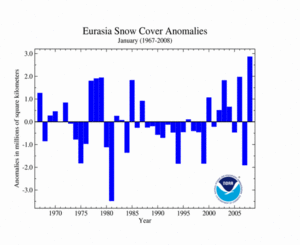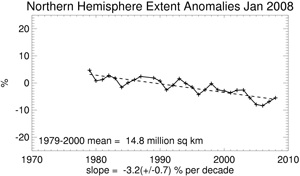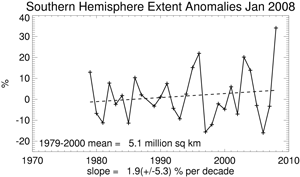Northern Hemisphere Snow Cover Extent
As shown in the time series to the right, mean Northern Hemisphere snow cover extent during January 2008 was much above average. This can be attributed to a series of snow storms that struck much the Northern Hemisphere during the month of January. The January 2008 snow cover extent was the largest extent over the 42-year historical record, surpassing the previous record set in 1985. The mean Northern Hemisphere January snow cover extent for the 1967-2008 period of record is 47.0 million square kilometers.
Snow cover for January 2008 across North America was above average, being the 13th largest extent since records began in 1967. During the month of January, much of the contiguous U.S. experienced a series of snow storms. The mean North American January snow cover extent is 17.5 million square kilometers for the 1967-2008 period of record.
As depicted in the time series to the right, Eurasia's snow cover extent in January was much above average and was the largest extent over the 42-year historical period. During January, severe winter weather brought freezing temperatures and heavy snow across much of China and central Asia. In some areas, snow fell for the first time in living memory. On average, Eurasian January snow cover extent is 29.4 million square kilometers for the 1967-2008 period of record.
Data were provided by the Global Snow Laboratory, Rutgers University.
Sea Ice Extent
According to the National Snow and Ice Data Center, the January 2008 Northern Hemisphere sea ice extent, which is measured from passive microwave instruments onboard NOAA satellites, was below the 1979-2000 mean, but greater than the previous four years. Sea ice extent for January has decreased at a rate of 3.2%/decade (since satellite records began in 1979) as temperatures in the high latitude Northern Hemisphere have risen at a rate of approximately 0.37°C/decade over the same period.
Meanwhile, the January 2008 Southern Hemisphere sea ice extent was much above the 1979-2000 mean. This was the largest sea ice extent in January over the 30-year historical period. Sea ice extent for January has increased at a rate of 1.9%/decade.
For further information on the Northern and Southern Hemisphere snow and ice conditions, please visit the NSIDC News page, provided by the NOAA's National Snow and Ice Data center (NSIDC).
 NOAA's National Centers for Environmental Information
NOAA's National Centers for Environmental Information
